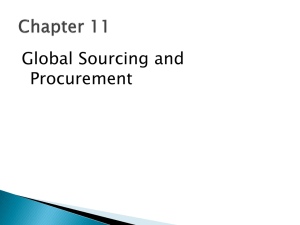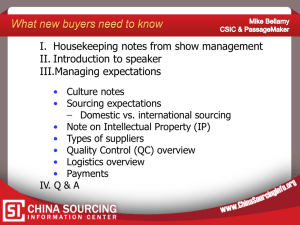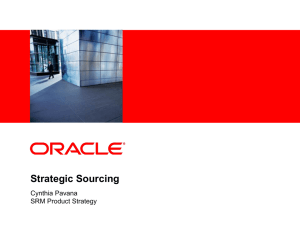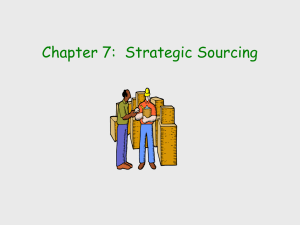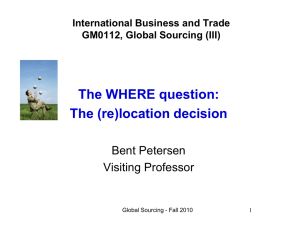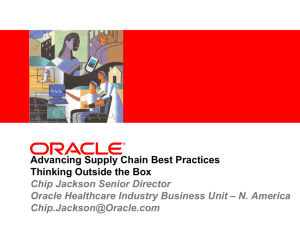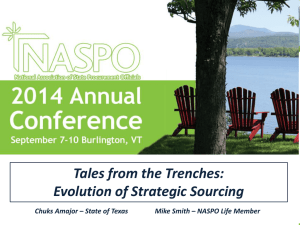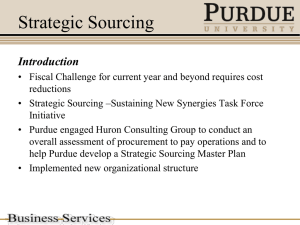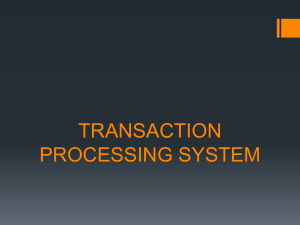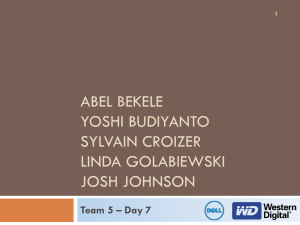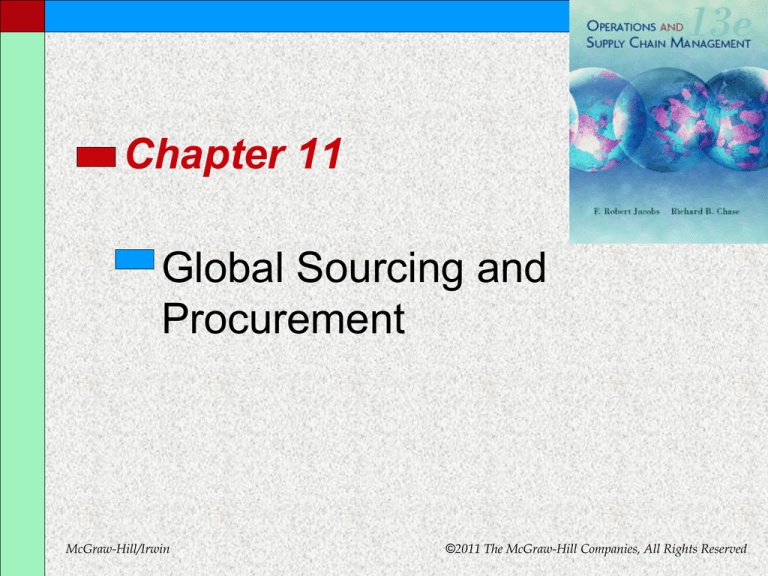
Chapter 11
Global Sourcing and
Procurement
McGraw-Hill/Irwin
©2011 The McGraw-Hill Companies, All Rights Reserved
Learning Objectives
Understand how important sourcing decisions go
beyond simple material purchasing decisions.
Demonstrate the “bullwhip effect” and how it is
important to synchronize the flow of material
between supply chain partners.
Describe how characteristics of supply and
demand have an impact on structuring supply
chains.
Know the reason for outsourcing capabilities.
Illustrate what “green” sourcing is.
Analyze the total cost of ownership.
Calculate inventory turnover and days of supply.
11-2
Supply-Chain & SCM
Supply-chain describes how organizations (suppliers,
manufacturers, distributors, and customers) are linked
together
Supply chain management is a total system approach to
managing the entire flow of information, materials, and
services from raw-material suppliers through factories and
warehouses to the end customer
Services
Supply networks
Manufacturing
Suppliers
Inputs
Suppliers
Service support
operations
Transformation
Manufacturing
Local service
providers
Customers
Localization
Output
Distribution
Customers
11-3
Supply Chain Management
Applies a total systems approach to
managing the entire flow of:
Raw
Material
Suppliers
Information
Materials, and
Services
Factories
&
Warehouses
End
Customer
11-4
SCM Functions
Forecasting demand
Selecting suppliers
Sourcing
Ordering materials
Inventory control
Scheduling production
Shipping & delivery
Information management
Quality management
Customer service
11-5
Strategic Sourcing
LO 1
Strategic sourcing: the development and
management of supplier relationships to
acquire goods and services in a way that
aids in achieving the immediate needs of
the business
In the past, sourcing was another name for
purchasing
As a result of globalization, sourcing
implies a more complex process suitable
for products that are strategically important
11-6
The Sourcing/Purchasing
Design Matrix
LO 1
11-7
Strategic Sourcing Continued
Specificity: refers to how common the
item is and, in a relative sense, how many
substitutes might be available
Commonly available products can be purchased
using a relatively simple process
A request for proposal (RFP) is used for
purchasing items that are more complex or
expensive and where there may be a
number of potential vendors
Vendor managed inventory: when a
customer actually allows the supplier to
manage an item or group of items for them
LO 1
11-8
Uncertainties In Sourcing
Wrong forecasts
Late deliveries
Poor quality
Machine breakdowns
Canceled orders
Erroneous information
11-9
Increasing Variability of
Orders up the Supply Chain
A lot of retailers each with little
variability in their orders….
…can lead to greater variability for a
fewer number of wholesalers, and…
…can lead to even
greater variability for a
single manufacturer.
LO 3
11-10
The Bullwhip Effect
Bullwhip effect: phenomenon of
variability magnification as we move
from the customer to the producer in
the supply chain
A slight change in consumer sales ripples
backward as magnified oscillations upstream,
like the result of a flick of a bullwhip handle
Continuous replenishment: inventory
is replaced frequently, as part of an
ongoing process
Match SC with the right products
LO 2
Functional or innovative
11-11
Supply-Chain
Performance
Customer
Customer
Pull
Pull
Dell
Retail Store
PC Manufacturer
Supplier
Dell Supply Chain
Supplier
Traditional PC Supply Chain11-12
Lead Time Reduction
Suppliers
Tier-n
Tier-1
Kansas
Chicago
Dallas
Buffalo
• Internal Setup:
• Performed with m/c idle
• Takes extra time
• Negative impact on SC
• External Setup:
• Performed with m/c running
• Absorbed by m/c time
• Takes less time
Distributors
Customers
Akron
1
Pittsburgh
2
Manufacturer
Denver
Cleveland
• Setup: internal/external
Toledo
3
Kentucky
n
• Convert internal to external
• Use visual control
• Clamping devices not bolts
Seattle
Atlanta
• Order batching
• Price fluctuations
• Forecasting
• Order rationing
11-13
Functional Products
Functional products include the staples
that people buy in a wide range of
retail outlets, such as grocery stores
and gas stations
Product life cycle of more than two years
Contribution margin of 5 to 20 percent
Only 10 to 20 product variations
An average forecast error of only 10 percent
Lead time for make-to-order products of from
six months to one year
LO 3
11-14
Innovative Products
Innovation can enable a company to
achieve higher profit margins
Newness of the innovative products
makes demand for them unpredictable
Typically have a life cycle of just a few
months
LO 3
Imitators quickly erode the competitive advantage
that innovative products enjoy
Companies are forced to introduce a steady
stream of newer innovations
The short life cycles and the great variety
typical of these products further increase
unpredictability
11-15
Demand and Supply
Uncertainty Characteristics
LO 3
11-16
Hau Lee’s Uncertainty Framework—
Examples and Types of Supply Chain
Needed
LO 3
11-17
Four Types of Supply
Chain Strategies
Efficient supply chains: utilize strategies
aimed at creating the highest cost efficiency
Risk-hedging supply chains: utilize
strategies aimed at pooling and sharing
resources in a supply chain to share risk
Responsive supply chains: utilize
strategies aimed at being responsive and
flexible
Agile supply chains: utilize strategies aimed
at being responsive and flexible to customer
LO 3
needs
11-18
Outsourcing
Outsourcing: the act of moving a firm’s
internal activities and decision
responsibility to outside providers
Allows a company to create a
competitive advantage while reducing
cost
An entire function may be outsourced, or
some elements of an activity may be
outsourced, with the rest kept in-house
LO 4
11-19
Reasons to Outsource and the
Resulting Benefits
LO 4
11-20
Logistics
Logistics: the management functions
that support the complete cycle of
material flow
Purchase and internal control of materials
Planning and control of WIP
Purchasing, shipping, and distribution of
finished product
Emphasis on lean inventory means
there is less room for delivery errors
LO 4
11-21
A Framework for Structuring
Supplier Relationships
LO 3
11-22
Green Sourcing
Being environmentally responsible has
become a business imperative
Many firms are looking to their supply
chains to deliver “green” results
Financial results can often be improved
Through going green
A comprehensive green sourcing effort
should assess how a company uses
items that are purchased internally
It is also important to reduce waste
LO 5
11-23
Six Step Process to Green
Sourcing
LO 5
11-24
Total Cost of Ownership
Total cost of ownership (TCO): an
estimate of the cost of an item that
includes all the costs related to the
procurement and use of an item,
including any related costs in disposing
of the item
Can be applied to internal costs or
more broadly to costs throughout the
supply chain
LO 6
11-25
Total Cost of Ownership
Factors
LO 6
11-26
Measuring Sourcing
Performance
Inventory turnover: how often inventory
is replaced during the year
Cost of goods sold: the annual cost for a
company to produce the goods or services
provided to customers
Average aggregate inventory value: the total
value of all items held in inventory
Weeks of supply: how many weeks’
worth of inventory is in the system at a
particular point in time
LO 7
11-27
Dell’s: Supply-Chain
Performance
Dell’s Inventory Turnover Data*
Year
1992
1993
1994
1995
1996
1997
1998
1999
2000
2001
Inventory Turnover
Week's Inventory
4.79
5.16
9.40
9.80
24.20
41.70
52.40
52.40
51.40
63.50
* http://www.inventorymanagementreview.org/2005/09/dell_computers_.html
Copyright © 2005 Dotmarketer | All Rights Reserved
10.856
10.078
5.532
5.306
2.149
1.247
0.992
0.992
1.012
0.819
11-28
Calculations
Cost of goods sold
Inventoryturnover
Averageaggregateinventoryvalue
Averageaggregateinventoryvalue
Weeksof supply
52
Cost of goods sold
LO 7
11-29
Example
Cost of goods sold
Averageaggregateinventoryvalue
40,190
87.56 turnsper year
228 231
Inventoryturnover
Averageaggregateinventoryvalue
52
Cost of goods sold
228 231
52 0.59 week
40,190
Weeksof supply
LO 7
11-30

